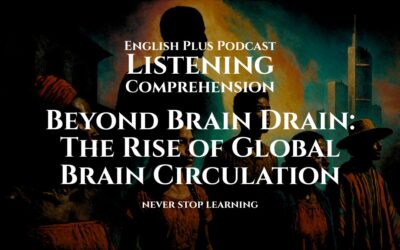Introduction
Welcome to your listening comprehension practice! Excelling in the listening section of international exams is about more than just understanding words; it’s about active engagement with the audio. For this exercise, as you listen, try to anticipate the direction of the conversation. Pay attention to signposting language—words and phrases that speakers use to signal a new idea, a contrasting point, or a conclusion. For example, listen for cues like “On the other hand,” “To give you an example,” or “In a nutshell.” This will help you to follow the speaker’s train of thought and identify the main arguments and supporting details. Remember, the goal is not to understand every single word, but to grasp the overall message and the key points.
Listening Audio
Listening Transcript: Please do not read the transcript before you listen and answer the questions.
Interviewer: Welcome, Dr. Anya Sharma, a distinguished professor of business innovation. Thank you for joining us.
Dr. Sharma: It’s a pleasure to be here.
Interviewer: We’re here today to talk about a topic that’s on everyone’s mind: the influence of technology on the business landscape. It feels like we’re in the midst of a whirlwind of change.
Dr. Sharma: That’s a very apt description. The pace of technological adoption has been nothing short of revolutionary. We’re seeing a fundamental restructuring of business models across virtually every sector. The digital transformation is not just about integrating new tools; it’s about a complete paradigm shift in how companies operate, create value, and engage with their customers.
Interviewer: Could you elaborate on that? What does this “paradigm shift” look like in practice?
Dr. Sharma: Certainly. Take the retail sector, for instance. E-commerce has completely upended the traditional brick-and-mortar model. But it’s more than just online shopping. The use of big data and artificial intelligence allows for hyper-personalization of the customer experience. Companies can now anticipate consumer needs and tailor their offerings in real-time. This is a far cry from the one-size-fits-all approach of the past. Moreover, the supply chain has been optimized with automation and IoT devices, leading to unprecedented efficiency.
Interviewer: That’s a great example. What about other industries?
Dr. Sharma: The financial sector is another area undergoing a profound transformation. The rise of fintech has democratized access to financial services. Mobile banking, peer-to-peer lending, and robo-advisors have made financial management more accessible and affordable for the average person. This has forced traditional banking institutions to innovate and adapt or risk becoming obsolete.
Interviewer: With all these advancements, there must be challenges as well. What are some of the hurdles businesses are facing?
Dr. Sharma: Absolutely. One of the biggest challenges is the digital divide. While large corporations have the resources to invest in cutting-edge technology, smaller enterprises can struggle to keep up. There’s also the issue of cybersecurity. As businesses become more reliant on digital infrastructure, they also become more vulnerable to cyber threats. The cost of a single data breach can be astronomical, not to mention the reputational damage.
Interviewer: That brings up the question of the workforce. How is technology impacting jobs?
Dr. Sharma: This is a complex and often contentious issue. On one hand, automation is leading to job displacement in certain sectors, particularly in roles that involve repetitive tasks. However, it’s also creating new roles that require a different set of skills. The demand for data scientists, AI specialists, and cybersecurity experts has skyrocketed. The key for the workforce of the future is continuous learning and adaptability. Lifelong learning is no longer just a buzzword; it’s a necessity.
Interviewer: So, what’s your outlook for the future? What can we expect to see in the next decade?
Dr. Sharma: I’m cautiously optimistic. I believe that technology, if managed responsibly, has the potential to solve some of the world’s most pressing problems. We’re on the cusp of major breakthroughs in areas like sustainable energy, personalized medicine, and global connectivity. However, it’s crucial that we address the ethical implications of these technologies. We need to ensure that the benefits of technological progress are shared equitably and that we mitigate the risks. The future is not predetermined; it’s up to us to shape it in a way that is both innovative and humane.
Listening Quiz
Keywords & Phrases
- Apt description: This means a description that is very suitable or appropriate for a particular situation. In the listening, the interviewer says “a whirlwind of change,” and Dr. Sharma agrees that this is an “apt description” of the current technological landscape.
- Paradigm shift: A paradigm shift is a fundamental change in the basic concepts and experimental practices of a scientific discipline. In a broader sense, like in the listening, it refers to a major change in how something is done or thought about. Dr. Sharma uses it to describe the complete change in business models due to technology.
- Hyper-personalization: This refers to the use of data and artificial intelligence to create highly individualized experiences for customers. In the listening, Dr. Sharma gives the example of retail companies using hyper-personalization to anticipate what customers want.
- Upended: To upend something means to turn it upside down or to cause a major change or disruption. Dr. Sharma says that e-commerce has “upended” the traditional retail model, meaning it has completely changed it.
- Brick-and-mortar: This term refers to a traditional business that has a physical presence in a building or other structure. Dr. Sharma contrasts the “brick-and-mortar” model with e-commerce, which is online.
- Democratized: To democratize something means to make it accessible to everyone. In the listening, Dr. Sharma says that fintech has “democratized” access to financial services, meaning more people can now access them.
- Obsolete: If something is obsolete, it is no longer produced or used because it is out of date. Dr. Sharma warns that traditional banks could become “obsolete” if they don’t innovate.
- Digital divide: This refers to the gap between those who have access to modern information and communication technology and those who do not. Dr. Sharma mentions this as a challenge, especially for small businesses.
- Contentious issue: A contentious issue is one that causes a lot of disagreement or argument. The impact of technology on jobs is described as a “contentious issue” because people have strong and conflicting opinions about it.
- On the cusp of: This phrase means to be at the point where something is about to happen. Dr. Sharma says we are “on the cusp of” major breakthroughs in technology, meaning they are very close to happening.










0 Comments